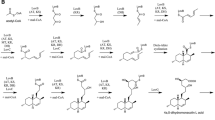Abstract
Aspergillus terreus produces the hypocholesterolemic compound mevinolin. Its growth and mevinolin production were affected by the composition of the culture medium. Both were at a maximum with glucose (6%) as the sole carbon source and in the presence of a mixture of yeast extract and sodium nitrate as nitrogen source. Influence of the concentration of some inorganic salts are also discussed.
Similar content being viewed by others
References
Alberts A.W., Chen J., Kuron G., Hunt V., Huff J., Huff C., Hoffman C., Rothrock I., Lopez M., Joshua H., Harris E., Patchett A., Monaghan R., Currie S., Stapley E., Albers-Schonberg G., Hensens O., Hirshfield J., Hoogsten K., Liesch J., Springer J.: Mevinolin: a highly potent competitive inhibitor of 3-hydroxy-3-methylglutaryl-coenzyme A reductase and cholesterol lowering agent.Proc. Nat. Acad. Sci. USA 77, 3957–3961 (1980).
Andrea H., Bach T.J.: Effects of mevinolin on cell cycle progression and viability of tobacco By-2 cells.Plant J. 14, 65–74 (1998).
Antonia J., Konya A., Ilkoy E., Boros S., Horvath G., Suto J.: Microbial conversion of mevinolin.J. Antibiot. 50, 750–754 (1997).
Deacon J.W.:Modern Mycology, 3rd ed. Blackwell Science Ltd., London 1997.
Endo A.: Monacolin k, a new hypocholesterolemic agent produced by aMonascus species.J Antibiot. 32, 852–854 (1979).
Endo A.: Chemistry, biochemistry and pharmacology of HMG-CoA reductase inhibitors.Klin. Wochenschr. 66, 421–427 (1988).
Endo A., Hasumi K., Negishi S.: Monacolins J and L, new inhibitors of cholesterol biosynthesis produced byMonascus ruber.J. Antibiot. 38, 420–422 (1985).
Frishman W.H., Zimetbaum P., Nadelmann J.: Lovastatin and other HMG-CoA reductase inhibitors.J. Clin. Pharmacol. 29, 975–982 (1989).
Goldstein J.L., Brown M.S.: Regulation of the mevalonate pathway.Nature 343, 425–430 (1990).
Greenspan M.D., Yudkovitz J.B.: Mevinolinic acid biosynthesis byAspergillus terreus and its relationship to fatty acid biosynthesis.J. Bacteriol. 162, 704–707 (1985).
Gunde-Cimerman N., Cimerman A.:Pleurotus fruiting bodies contain the inhibitor of 3-hydroxy-3-methylglutaryl-coenzyme A reductase lovastatin.Exp. Mycol. 19, 1–6 (1995).
Gunde-Cimerman N., Friedrich J., Cimerman A., Benički: Screening fungi for the production of an inhibitor of HMG-CoA reductase: production of mevinolin by the fungi of the genusPleurotus.FEMS Microbiol. Lett. 111, 203–206 (1993).
Josekutty P.C.: Inhibition of plant growth by mevinolin and reversal of this inhibition by isoprenoids.South Afric. J. Bot. 64, 18–24 (1998).
Monaghan R.L., Alberts A.W., Hoffman C.H., Albers-Schonberg G.: Hypocholesterolemic fermentation products and process of preparation.US Pat. 4 231 938 (1980).
Moore R.N., Bigam G., Chan J.K., Hogg A.M., Nakashima T.T., Vederas J.C.: Biosynthesis of the hypocholesterolemic agent mevinolin byAspergillus terreus. Determination of the origin of carbon, hydrogen and oxygen atoms by13C NMR and mass spectrometry.J. Am. Chem. Soc. 107, 3694–3701 (1985).
Reid I.: Effects of nitrogen source on cellulose and synthetic lignin degradation byPhanerochœte chrysosporium.Appl. Environ. Microbiol. 45, 838–842 (1983).
Sabry S.A., El-Refai A.H., Gamati S.Y.: Riboflavin formation by mould fungi cultivated on hydrocarbon containing media.Microbios 57, 33–40 (1989a).
Sabry S.A., El-Refai A.H., Gamati S.Y.: Production of riboflavin (vitamin B2) by hydrocarbon-utilization yeasts.Microbiologia SEM 5, 45–52 (1989b).
Shindia A.A.: Mevinolin production by some fungi.Folia Microbiol. 42, 477–480 (1997).
Zuzek M., Friedrich J., Cestnik B., Karalic A., Cimerman A.: Optimization of fermentation medium by a modified method of genetic algorithms.Biotechnol. Techn. 10, 991–996 (1996).
Author information
Authors and Affiliations
Rights and permissions
About this article
Cite this article
Shindia, A.A. Some nutritional factors influencing mevinolin production byAspergillus terreus strain. Folia Microbiol 46, 413–416 (2001). https://doi.org/10.1007/BF02814431
Received:
Issue Date:
DOI: https://doi.org/10.1007/BF02814431




